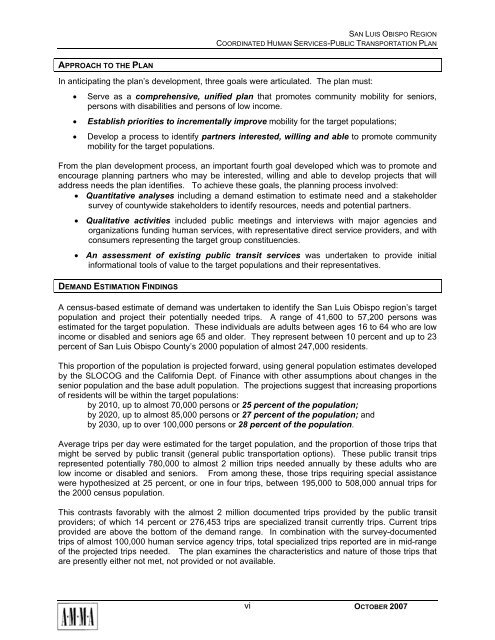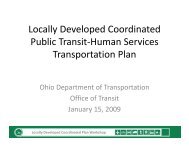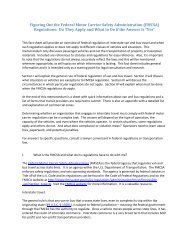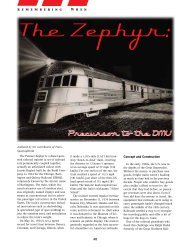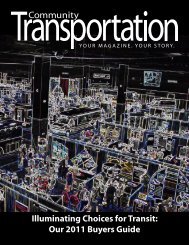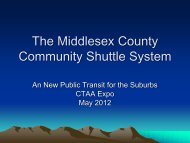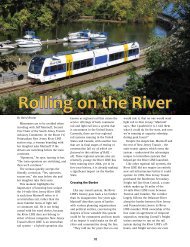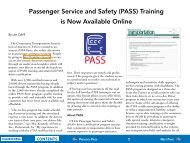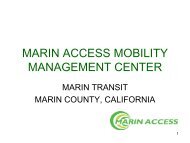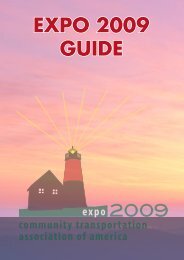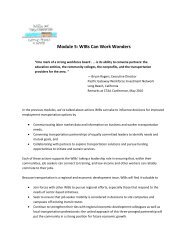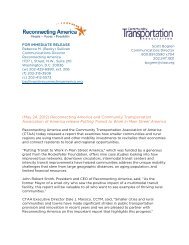San Luis Obispo - Caltrans - State of California
San Luis Obispo - Caltrans - State of California
San Luis Obispo - Caltrans - State of California
Create successful ePaper yourself
Turn your PDF publications into a flip-book with our unique Google optimized e-Paper software.
SAN LUIS OBISPO REGION<br />
COORDINATED HUMAN SERVICES-PUBLIC TRANSPORTATION PLAN<br />
APPROACH TO THE PLAN<br />
In anticipating the plan’s development, three goals were articulated. The plan must:<br />
• Serve as a comprehensive, unified plan that promotes community mobility for seniors,<br />
persons with disabilities and persons <strong>of</strong> low income.<br />
• Establish priorities to incrementally improve mobility for the target populations;<br />
• Develop a process to identify partners interested, willing and able to promote community<br />
mobility for the target populations.<br />
From the plan development process, an important fourth goal developed which was to promote and<br />
encourage planning partners who may be interested, willing and able to develop projects that will<br />
address needs the plan identifies. To achieve these goals, the planning process involved:<br />
• Quantitative analyses including a demand estimation to estimate need and a stakeholder<br />
survey <strong>of</strong> countywide stakeholders to identify resources, needs and potential partners.<br />
• Qualitative activities included public meetings and interviews with major agencies and<br />
organizations funding human services, with representative direct service providers, and with<br />
consumers representing the target group constituencies.<br />
• An assessment <strong>of</strong> existing public transit services was undertaken to provide initial<br />
informational tools <strong>of</strong> value to the target populations and their representatives.<br />
DEMAND ESTIMATION FINDINGS<br />
A census-based estimate <strong>of</strong> demand was undertaken to identify the <strong>San</strong> <strong>Luis</strong> <strong>Obispo</strong> region’s target<br />
population and project their potentially needed trips. A range <strong>of</strong> 41,600 to 57,200 persons was<br />
estimated for the target population. These individuals are adults between ages 16 to 64 who are low<br />
income or disabled and seniors age 65 and older. They represent between 10 percent and up to 23<br />
percent <strong>of</strong> <strong>San</strong> <strong>Luis</strong> <strong>Obispo</strong> County’s 2000 population <strong>of</strong> almost 247,000 residents.<br />
This proportion <strong>of</strong> the population is projected forward, using general population estimates developed<br />
by the SLOCOG and the <strong>California</strong> Dept. <strong>of</strong> Finance with other assumptions about changes in the<br />
senior population and the base adult population. The projections suggest that increasing proportions<br />
<strong>of</strong> residents will be within the target populations:<br />
by 2010, up to almost 70,000 persons or 25 percent <strong>of</strong> the population;<br />
by 2020, up to almost 85,000 persons or 27 percent <strong>of</strong> the population; and<br />
by 2030, up to over 100,000 persons or 28 percent <strong>of</strong> the population.<br />
Average trips per day were estimated for the target population, and the proportion <strong>of</strong> those trips that<br />
might be served by public transit (general public transportation options). These public transit trips<br />
represented potentially 780,000 to almost 2 million trips needed annually by these adults who are<br />
low income or disabled and seniors. From among these, those trips requiring special assistance<br />
were hypothesized at 25 percent, or one in four trips, between 195,000 to 508,000 annual trips for<br />
the 2000 census population.<br />
This contrasts favorably with the almost 2 million documented trips provided by the public transit<br />
providers; <strong>of</strong> which 14 percent or 276,453 trips are specialized transit currently trips. Current trips<br />
provided are above the bottom <strong>of</strong> the demand range. In combination with the survey-documented<br />
trips <strong>of</strong> almost 100,000 human service agency trips, total specialized trips reported are in mid-range<br />
<strong>of</strong> the projected trips needed. The plan examines the characteristics and nature <strong>of</strong> those trips that<br />
are presently either not met, not provided or not available.<br />
vi<br />
OCTOBER 2007


